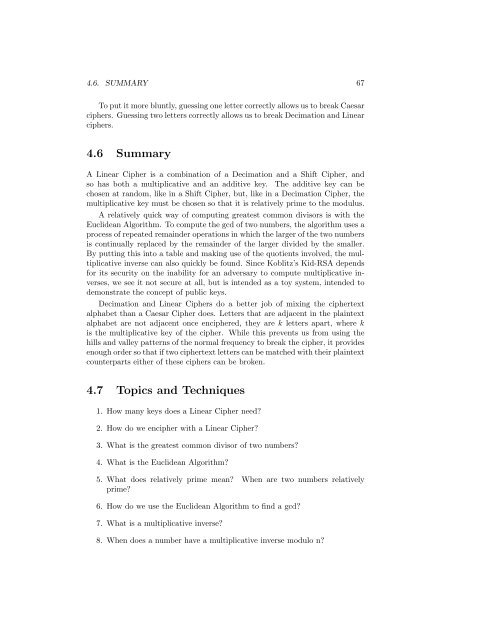Cryptology - Unofficial St. Mary's College of California Web Site
Cryptology - Unofficial St. Mary's College of California Web Site
Cryptology - Unofficial St. Mary's College of California Web Site
Create successful ePaper yourself
Turn your PDF publications into a flip-book with our unique Google optimized e-Paper software.
4.6. SUMMARY 67<br />
To put it more bluntly, guessing one letter correctly allows us to break Caesar<br />
ciphers. Guessing two letters correctly allows us to break Decimation and Linear<br />
ciphers.<br />
4.6 Summary<br />
A Linear Cipher is a combination <strong>of</strong> a Decimation and a Shift Cipher, and<br />
so has both a multiplicative and an additive key. The additive key can be<br />
chosen at random, like in a Shift Cipher, but, like in a Decimation Cipher, the<br />
multiplicative key must be chosen so that it is relatively prime to the modulus.<br />
A relatively quick way <strong>of</strong> computing greatest common divisors is with the<br />
Euclidean Algorithm. To compute the gcd <strong>of</strong> two numbers, the algorithm uses a<br />
process <strong>of</strong> repeated remainder operations in which the larger <strong>of</strong> the two numbers<br />
is continually replaced by the remainder <strong>of</strong> the larger divided by the smaller.<br />
By putting this into a table and making use <strong>of</strong> the quotients involved, the multiplicative<br />
inverse can also quickly be found. Since Koblitz’s Kid-RSA depends<br />
for its security on the inability for an adversary to compute multiplicative inverses,<br />
we see it not secure at all, but is intended as a toy system, intended to<br />
demonstrate the concept <strong>of</strong> public keys.<br />
Decimation and Linear Ciphers do a better job <strong>of</strong> mixing the ciphertext<br />
alphabet than a Caesar Cipher does. Letters that are adjacent in the plaintext<br />
alphabet are not adjacent once enciphered, they are k letters apart, where k<br />
is the multiplicative key <strong>of</strong> the cipher. While this prevents us from using the<br />
hills and valley patterns <strong>of</strong> the normal frequency to break the cipher, it provides<br />
enough order so that if two ciphertext letters can be matched with their plaintext<br />
counterparts either <strong>of</strong> these ciphers can be broken.<br />
4.7 Topics and Techniques<br />
1. How many keys does a Linear Cipher need<br />
2. How do we encipher with a Linear Cipher<br />
3. What is the greatest common divisor <strong>of</strong> two numbers<br />
4. What is the Euclidean Algorithm<br />
5. What does relatively prime mean When are two numbers relatively<br />
prime<br />
6. How do we use the Euclidean Algorithm to find a gcd<br />
7. What is a multiplicative inverse<br />
8. When does a number have a multiplicative inverse modulo n

















